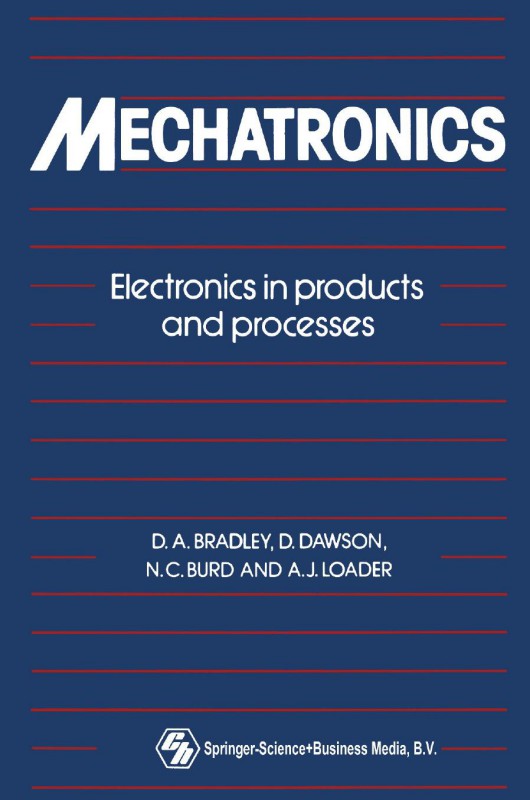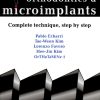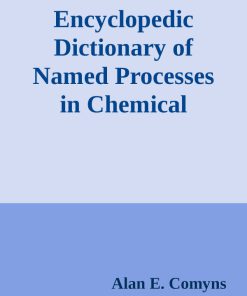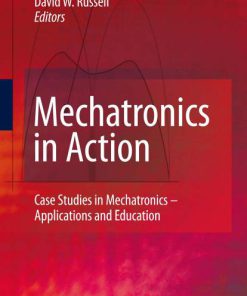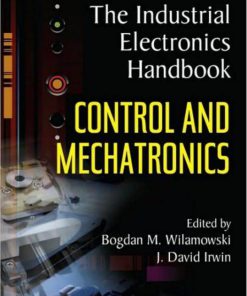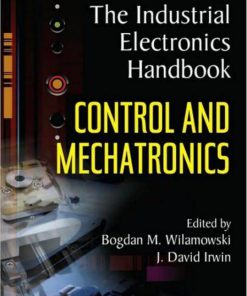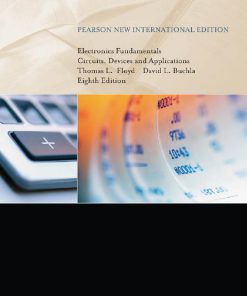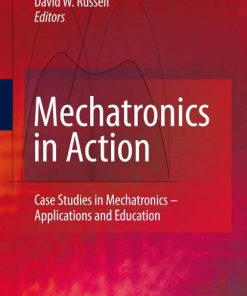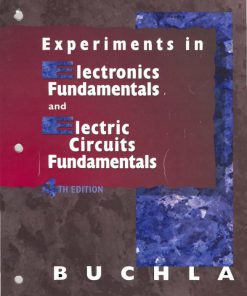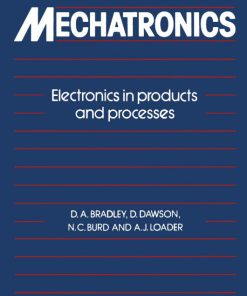Mechatronics Electronics in Products and Processes 1st Edition by David Allan Bradley, Alan Loader, Burd, David Dawson 0367111888 9780367111885
$50.00 Original price was: $50.00.$25.00Current price is: $25.00.
Authors:D.A. Bradley , Series:Mechatronics Engineering [123] , Author sort:Bradley, D.A. , Languages:Languages:eng , Published:Published:Sep 2011 , Publisher:SPRTNGER-SCTENCE+BUSTNESS MEDIA, B.V.
Mechatronics Electronics in Products and Processes 1st Edition by David Allan Bradley, Alan Loader, Burd, David Dawson – Ebook PDF Instant Download/Delivery. 0367111888, 9780367111885
Full download Mechatronics Electronics in Products and Processes 1st Edition after payment
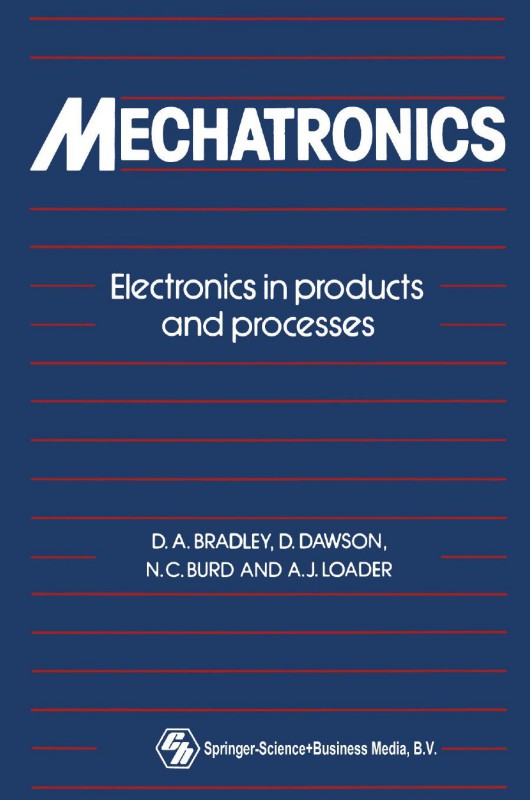
Product details:
ISBN 10: 0367111888
ISBN 13: 9780367111885
Author: David Allan Bradley, Alan Loader, Burd, David Dawson
Mechatronics: Electronics in Products and Processes identifies the concepts which underpin the mechatronic approach to engineering design and brings together its principle components – sensors and transducers, embedded microprocessors, actuators and drives – to explore their interrelationships. The text focuses primarily on hardware elements and the impact of system architecture. Modern technology is set in an historical background and each chapter comes with learning objectives and chapter outlines. The book includes numerous case studies illustrating the concepts applied in such areas as automatic cameras, aerospace parts manufacturing, fly-by-wire systems, and boat autopilot.
Mechatronics Electronics in Products and Processes 1st Table of contents:
1 What is mechatronics?
1.1 Mechatronics in manufacturing
1.2 Mechatronics in products
1.3 Mechatronics and engineering design
1.3.1 A modular approach to mechatronics and engineering design
1.4 The engineer and mechatronics
1.5 Mechatronics and technology
Part One Sensors and Transducers
2 Measurement systems
2.1 Sensors, transducers and measurement
2.2 Classification
2.2.1 Classification by function
2.2.2 Classification by performance
2.2.3 Classification by output
2.3 Developments in transducer technology
2.3.1 Solid state transducers
2.3.2 Optical transducers
2.3.3 Piezoelectric transducers
2.3.4 Ultrasonic transducers
2.4 Signal processing and information management
2.5 The design of a measurement system
3 Resistive, capacitive, inductive and resonant transducers
3.1 Resistive transducers
3.1.1 Potentiometers
3.1.2 Strain gauges
3.1.3 Resistive temperature transducers
3.2 Capacitive transducers
3.3 Inductive transducers
3.3.1 Linear variable differential transformer
3.3.2 Linear variable inductive transducer
3.3.3 The inductosyn
3.3.4 Inductive velocity transducers
3.4 Thermoelectric transducers
3.5 Resonant transducers
3.5.1 Vibrating wire transducers
3.5.2 Vibrating beam transducers
3.5.3 Vibrating cylinder transducers
4 Optical measurement systems
4.1 Radiant energy sources
4.1.1 Incandescent lamps
4.1.2 Discharge lamps
4.1.3 Light emitting diodes
4.1.4 Lasers
4.1.5 Illumination
4.2 Photodetectors
4.2.1 Thermal photodetectors
4.2.2 Quantum photodetectors
4.2.3 Array detectors
4.3 Vision systems
4.3.1 Image processing
4.4 Laser scanning
4.5 Fibre optic transducers
4.5.1 Intensity modulation
4.5.2 Phase modulation
4.5.3 Modulation of the angle of polarization
4.5.4 Modulation of wavelength and spectral distribution
4.6 Non-fibre optical transducers
4.6.1 Optical encoders
4.6.2 Tactile sensing
4.6.3 Triangulation
5 Solid state sensors and transducers
5.1 Magnetic measurements
5.1.1 Hall effect
5.1.2 Magnetoresistor
5.1.3 Magnetodiode
5.1.4 Magnetotransistor
5.2 Temperature measurements
5.2.1 Thermistor
5.2.2 Thermodiodes and thermotransistors
5.2.3 Seebeck effect devices
5.2.4 Solid state pyrometers
5.3 Mechanical measurements
5.3.1 Strain
5.3.2 Force
5.4 Chemical measurements
5.4.1 Humidity
5.4.2 Gas detectors
6 Piezoelectric and ultrasonic sensors and transducers
6.1 Piezoelectric devices
6.1.1 Accelerometers
6.1.2 Humidity measurement
6.1.3 Surface acoustic wave devices
6.1.4 Light modulation
6.1.5 Piezoelectric actuators
6.2 Ultrasonic systems
6.2.1 Sources
6.2.2 Coupling of the source
6.2.3 Receivers
6.2.4 Ultrasonic flow measurement
6.2.5 Ultrasonic distance measurement
6.2.6 Ultrasonic measurement using variation in transmission velocity
6.2.7 Ultrasonic imaging
7 Interference and noise in measurement
7.1 Interference
7.1.1 Common mode rejection ratio
7.1.2 Ground or earth loops
7.1.3 Electrostatic interference: screening and guarding
7.1.4 Electromagnetic interference
7.1.5 Power supplies as a source of interference
7.2 Noise
7.2.1 White and coloured noise
7.2.2 Sources of noise
7.2.3 Noise factor
7.2.4 Signal-to-noise ratio
8 Signal processing
8.1 Operational amplifiers
8.1.1 Integrator
8.1.2 Buffer amplifier
8.1.3 Current to voltage converter
8.1.4 Voltage to current converter
8.1.5 Logarithmic amplifier
8.1.6 Charge amplifier
8.1.7 Differential amplifier
8.1.8 Comparator
8.1.9 Schmitt trigger amplifier
8.2 Practical operational amplifiers
8.2.1 Amplifier errors
8.2.2 Chopper stabilized amplifiers
8.2.3 Auto-zeroing amplifier
8.3 Signal isolation
8.3.1 Isolation amplifier
8.3.2 Opto-isolation
8.3.3 Transformer isolation
8.4 Phase sensitive detector
8.4.1 Phase locked loop
8.5 Multiplexing
8.5.1 Time division multiplexing
8.5.2 Frequency division multiplexing
8.6 Filters
8.6.1 Analogue filters
8.6.2 Digital filters: the sampling theorem
8.6.3 Pre-processing and post-processing filters
8.7 Digital signal processing
8.7.1 Analogue to digital and digital to analogue conversion
8.7.2 Signal analysis
8.8 Smart sensors
8.9 Expert systems, artificial intelligence and measurement
Part Two Embedded Microprocessor Systems
9 Microprocessors in mechatronic systems
9.1 Embedded real-time microprocessor systems
9.2 The mechatronic system
10 The microprocessor system
10.1 The system components
10.2 The system bus
10.3 The memory map
10.4 The microprocessor bus operation
11 The central processing unit
11.1 CPU operation: the fetch phase
11.1.1 The program counter
11.1.2 The stack pointer
11.1.3 Instruction decode and control
11.1.4 Microcoded instruction decode and control
11.1.5 Hard wired control units
11.2 CPU operation: the execution phase
11.2.1 The arithmetic and logic unit and the accumulator
11.2.2 The processor status register
11.2.3 The register bank
11.3 Interrupt processing
11.3.1 Register stacking and context switching
11.3.2 Systems with multiple interrupt sources
11.3.3 Non-vectored interrupts
11.3.4 Vectored interrupts
11.3.5 Multiple interrupt processing
11.3.6 Non-maskable interrupts and CPU reset
11.4 The central processor unit instruction set
11.5 Addressing modes
11.5.1 Immediate addressing
11.5.2 Direct addressing
11.5.3 Paged addressing
11.5.4 Indirect addressing
11.5.5 Indexed addressing
11.5.6 Relative addressing
11.5.7 Stack addressing
11.6 CISC and RISC instruction sets
12 Semiconductor memory, input and output, and peripheral circuits
12.1 Semiconductor memory devices
12.1.1 Read only memory
12.1.2 Read/write memories
12.2 Input and output devices
12.2.1 Parallel I/O
12.2.2 Interrupt support
12.2.3 Data transfer using handshaking
12.2.4 Serial I/O
12.2.5 Analogue to digital and digital to analogue converters
12.3 Peripheral circuits
12.3.1 Programmable counter/timers
12.3.2 Direct memory access
12.3.3 Interrupt controllers
12.4 Coprocessors
12.5 Microprocessor types
12.5.1 Microcontrollers
12.5.2 Example: the National Semiconductor HPC16083 microcontroller
12.5.3 Digital signal processors
13 Semi-custom devices, programmable logic and device technology
13.1 Application specific integrated circuits
13.1.1 Gate arrays
13.1.2 Standard cell and functional block ASICs
13.1.3 Analogue ASICs
13.2 Programmable logic devices
13.2.1 The programmable read only memory
13.2.2 The programmable logic array
13.2.3 Programmable array logic
13.2.4 Programming and reprogramming programmable logic devices
13.3 Semiconductor technologies
13.3.1 Some important characteristics
13.3.2 MOS technologies
13.3.3 Bipolar technologies
14 The development of microprocessor systems
14.1 The system specification
14.2 The development environment
14.3 The development cycle
14.3.1 The editor: entering the source program
14.3.2 Compilation and assembly: the generation of object code
14.3.3 Linking: relocatable and absolute object code
14.3.4 Object code libraries
14.3.5 Emulation and debugging
14.4 Assemblers, linkers and assembly language
14.4.1 An assembler program example
14.5 High level programming languages and compilers
14.6 The real-time multitasking executive
14.6.1 Tasks and task scheduling
14.6.2 Intertask communications and synchronization
14.6.3 Timing
14.6.4 Memory manager
14.6.5 An application example
15 Communications
15.1 Control and communication system hierarchies
15.2 Local area networks
15.2.1 Standards and the communication system reference model
15.2.2 LAN standards
15.2.3 LAN topology
15.2.4 LAN frame structure and medium access techniques
15.3 A communications system hierarchy for industrial automation applications
15.3.1 The manufacturing automation protocol
15.3.2 The enhanced performance architecture (EPA) MAP
15.3.3 Fieldbus
Part Three Motion Control
16 Drives and Actuators
17 Control devices
17.1 Electrohydraulic control devices
17.1.1 Flapper controlled electrohydraulic servovalve
17.1.2 Proportional solenoid Controlled Electrodynamic Value
17.1.3 Simple flapper orifice
17.2 Electropneumatic proportional controls
17.2.1 Direct proportional controls for pressure and flow
17.2.2 Pulse width modulation control of solenoid valves
17.3 Control of electrical drives: power semiconductor devices
17.3.1 Diodes
17.3.2 Thyristors
17.3.3 Gate turn-off thyristors
17.3.4 Triacs
17.3.5 Power transistors
17.3.6 Power MOSFETs
17.3.7 Insulated gate bipolar transistors
17.3.8 Smart power devices
17.3.9 Heat transfer and cooling
17.3.10 Protection
17.4 Converters, choppers, inverters and cycloconverters
17.4.1 Naturally commutated thyristor converters
17.4.2 DC choppers
17.4.3 Inverters
17.4.4 Cycloconverters
18 Linear systems
18.1 Pneumatic rams: rod type
18.2 Pneumatic rams: rodless type
18.3 Pneumatic diaphragms
18.4 Pneumatic bellows
18.5 Hydraulic cylinders
18.6 Motor and ball screw
18.7 Motor and leadscrew
18.8 Direct linear electrical actuators
18.9 Solenoids
18.10 Other forms of electrical actuator
19 Rotational drives
19.1 Pneumatic motors: continuous rotation
19.2 Pneumatic motors: limited rotation
19.3 Hydraulic motors: continuous rotation
19.3.1 Gear motors
19.3.2 Vane motors
19.3.3 Axial piston motors
19.3.4 Radial piston motors
19.3.5 General characteristics of rotational hydraulic transmissions
19.4 Hydraulic motors: limited rotation
19.5 Electrical motors
19.5.1 DC machines
19.5.2 DC variable speed drives
19.5.3 DC servomotors
19.5.4 Induction machines
19.5.5 AC variable speed drives
19.5.6 Stepper motors
19.5.7 Synchronous machines
19.5.8 Brushless machines
19.5.9 Switched reluctance motors
19.5.10 Toroidal torque motor
19.5.11 Electrical variable speed drive characteristics
20 Motion converters
20.1 Fixed ratio motion converters
20.1.1 Parallel shaft gears
20.1.2 Epicyclic gears
20.1.3 Harmonic drives
20.1.4 Worm and bevel gears
20.1.5 V belt drives
20.1.6 Toothed belt drivers
20.1.7 Chains and sprockets
20.1.8 Friction wire wrap drives
20.1.9 Rack and pinion
20.1.10 Screw nut systems
20.2 Motion converters with invariant motion profile
20.2.1 Cams
20.2.2 Indexing mechanisms
20.2.3 Linkages
20.2.4 Springs and dampers
20.3 Variators (continuously variable transmissions)
20.3.1 Conical pulley/disc systems
20.3.2 Ball/disc friction drive systems
20.3.3 Unit hydraulic transmissions
20.4 Remotely controlled couplings
Part Four Case Studies
21 Mechanical systems and design
21.1 Tradition versus mechatronics
21.2 The mechatronic approach
21.2.1 Replacement of mechanisms
21.2.2 Simplification of mechanisms
21.2.3 Enhancement of mechanisms
21.2.4 Synthesis of mechanisms
21.3 Control
21.3.1 Program control
21.3.2 Adaptive control
21.3.3 Distributed systems
21.4 The design process
21.4.1 Need
21.4.2 Feasibility
21.4.3 Specification
21.4.4 Conceptual design
21.4.5 Analysis and modelling
21.4.6 Embodiment and optimization
21.4.7 Detail design
21.5 Types of design
21.6 Integrated product design
21.6.1 Project management
21.6.2 Planning and implementation of facilities
22 Mechanisms
22.1 Load conditions
22.1.1 Actuator requirements
22.1.2 Attaining partial static balance
22.1.3 Articulation requirements
22.1.4 Speed versus accuracy
22.1.5 Minimization of kinetic energy
22.1.6 Power transmission over a distance
22.1.7 Effects of assembly play and friction
22.1.8 Inertia
22.2 Design
22.2.1 Materials
22.2.2 Sizing of actuators
22.3 Flexibility
22.3.1 Resilience
22.3.2 Backlash
22.3.3 Vibration
22.4 Modelling and simulation
22.4.1 GRASP
22.4.2 ADAMS/DRAMS
23 Structures
23.1 Load conditions
23.1.1 Static loading
23.1.2 Dynamic and cyclic loading
23.1.3 Impulse and shock loading
23.2 Flexibility
23.2.1 Flexible structures
23.2.2 Vibration effects
23.2.3 Materials
23.3 Environmental isolation
23.4 Modelling
23.5 Systems
24 Man-machine interface
24.1 Industrial design and ergonomics
24.1.1 Aesthetics and style
24.1.2 Ergonomics
24.2 Information transfer: from machine to man
24.2.1 Human responses to stimuli
24.3 Information transfer: from man to machine
24.4 Safety
24.4.1 Operator safety
24.4.2 System safety
Part Five Case Studies
25 Introduction to case studies
26 Canon EOS autofocus cameras
26.1 Main microprocessor
26.2 Exposure control
26.2.1 Diaphragm drive system
26.3 Autofocus
26.3.1 The BASIS sensor
26.3.2 Depth of field setting
26.3.3 Focusing drives
26.4 Lens microprocessor
26.5 Film transport system
27 Fly-by-wire
27.1 The EAP systems architecture and flight control system
27.2 The flight control computers
27.3 MIL-STD-1553: a digital data transmission system for military applications
28 British aerospace small parts flexible manufacturing system
28.1 Billet preparation
28.2 Steel and titanium parts
28.3 Aluminium parts
28.4 Control
29 Autohelm 800 boat autopilot
People also search for Mechatronics Electronics in Products and Processes 1st:
z electronics
u-tech electronics
c electronics
is mechatronics in high demand

